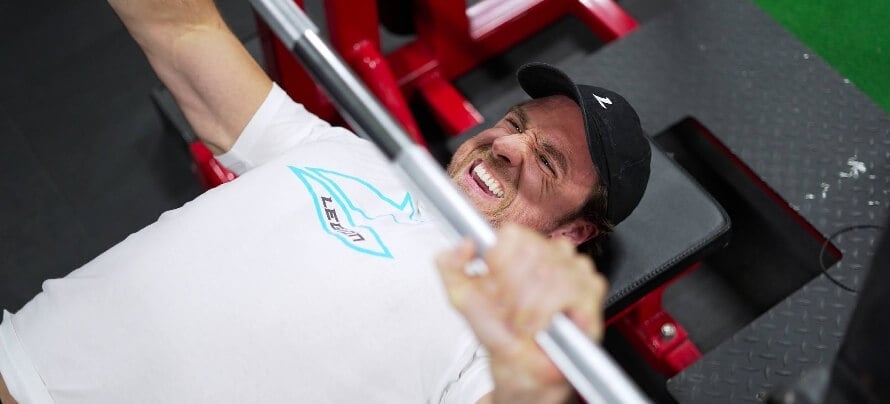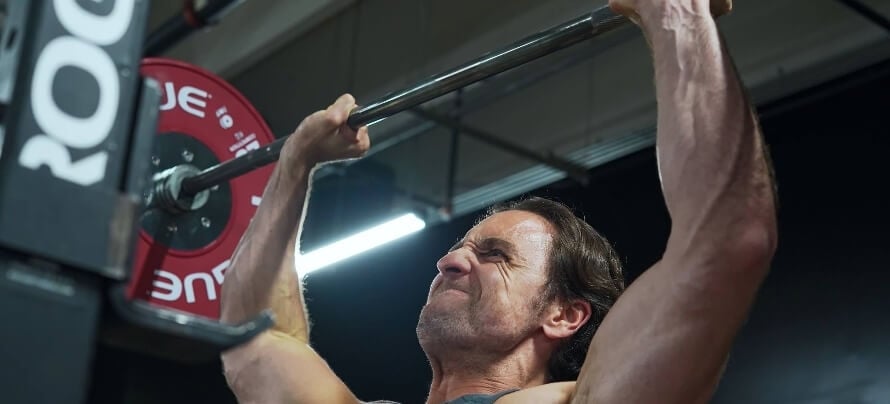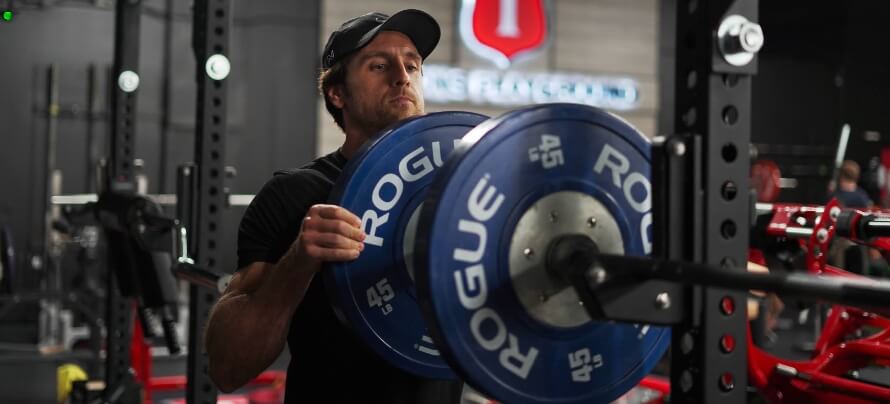You may have heard weightlifters talking about hitting a new “PR”, but what does a PR mean in the gym?
And why do people suggest hitting PRs is the gold standard of progress?
PR stands for “personal record,” and it represents your best-ever performance in a specific exercise.
There are several types of PRs in the gym, too, and each provides a different way to track your gains. But the common thread is this: if your PRs are going up over time, you’re getting stronger, bigger, faster, or fitter.
In this article, you’ll learn about all the types of gym PRs, why tracking them benefits progress, how to set and break a PR, and more.
Key Takeaways
- In the gym, a “PR” or “personal record” represents your best performance in a specific exercise, whether it’s your heaviest lift, most reps, or longest run.
- You can set multiple types of PRs—weight, rep, RPE, and volume PRs—all of which help you gauge improvements in strength.
- Since strength gain is a proxy for muscle growth, tracking PRs helps you understand if you’re building muscle.
- Tracking PRs also highlights your weakness, which helps you identify areas you need to improve.
- You can improve your performance during a PR attempt using the strategies discussed in this article.
What Does “PR” Mean in the Gym?

In the gym, “PR” stands for “personal record.” People also sometimes refer to a PR as a “PB,” or “personal best.”
It’s a term used to describe your best performance in a specific exercise—often the heaviest weight lifted for a single rep or the most reps completed at a certain weight.
For instance, if your best deadlift was 300 pounds and you pull 305, that’s a new PR. Or if you’ve benched 225 pounds for five reps and later manage six, that’s another PR.
Most people associate PRs in weightlifting with compound exercises like the squat, bench press, and deadlift, but you can set a PR in any exercise, even cardio.
For example, you might set a PR for your fastest 5-mile run, longest bike ride, or even the most consecutive days you’ve gone for a walk.
Types of PR in the Gym
In weightlifting, there are several types of PRs you can aim for:
- Weight PR: Your heaviest lift for a specific exercise. For example, if you squat 350 pounds for the first time, that’s a new weight PR. When you lift the maximum weight you can handle for a single rep, it’s also considered a one-rep max (1RM). However, weight PRs don’t always have to be 1RMs—they can also be your best lift for multiple reps, like a 3-rep max, for example.
- Rep PR: The most reps you can complete at a certain weight. If you manage 8 reps at 225 pounds on the bench press when your previous best was seven, you’ve set a new rep PR.
- RPE PR: Your best lift based on rate of perceived exertion (RPE), which measures how hard a set feels. If you deadlift 300 pounds with an RPE of 7 when it used to feel like a 9, that’s an RPE PR.
- Volume PR: Your highest total work done on a single exercise in a workout. For instance, if you do 12 total reps across 3 sets of squats one week, then complete 13 total reps across 3 sets the following week with the same weight, you’ve set a new volume PR.
While weight PRs tend to get the most attention among weightlifters, each type of PR provides valuable insights into how your strength and endurance are progressing.
Benefits of Tracking Personal Records (PRs) in the Gym

The main benefit of tracking PRs (weight, rep, RPE, and volume) is that it’s one of the most reliable ways to measure your progress—if they’re increasing over time, you’re gaining strength.
And that’s important because gaining strength is an excellent indication you’re gaining muscle.
Tracking your PRs also helps you ensure you’re training with enough intensity to maximize gains.
When it comes to hypertrophy, the sweet spot for training intensity is about 1-to-3 reps shy of failure (the point at which you can’t complete another rep with good form). Training closer to failure (0-to-1 reps shy) can interfere with recovery and long-term progress, while training further from failure (4+ reps shy) isn’t enough to maximize muscle gain.
Setting your training weights based on your PRs is one of the best ways to hit this “Goldilocks zone” of intensity. For example, if you know your all-out deadlift PR is 300 pounds for 4 reps, you might aim for around 280 pounds for 3 sets of 4-to-6 reps to ensure you’re training hard without overdoing it.
Another benefit of tracking PRs is that it keeps your workouts purposeful. Each PR tells you where you’re making strides and where you’re weakest, which helps you understand what you need to address.
In short, tracking PRs makes progress measurable and workouts meaningful—two essentials for long-term consistency and success in the gym.
How to Set and Break a PR
Setting regular PRs starts with following a well-designed strength training program.
Provided your routine focuses on progressive overload—the systematic process of lifting progressively heavier weights over time—you’ll have no issues setting rep, RPE, and volume PRs.
Setting a weight PR or one-rep max requires more strategy, though.
Here’s a step-by-step guide on how to do it. To keep things simple, let’s use setting a new squat PR as an example.
1. Estimate Your One-Rep Max
Start by calculating your estimated one-rep max for the squat using the calculator below.
For an accurate estimate, enter the most weight you’ve recently squatted for 6 reps or fewer.
The Best One-Rep Max Calculator for Any Exercise
For instance, if you recently squatted 200 pounds for 5 reps, the calculator will estimate your squat one-rep max at around 225 pounds.
2. Prioritize the Exercise
Move the squat to the very start of your next workout. For instance, if it’s usually the second or third exercise in your routine, shift it to first. This way, you’ll be fresh and able to lift the maximum amount of weight.
3. Warm Up Correctly
When you arrive at the gym for your squat PR workout, do a thorough warm-up. According to research, warming up with heavy weights is the best way to prime your body for heavy weightlifting.
Here’s the protocol I recommend:
- Do 6 reps with about 50% of your estimated one-rep max (110 pounds), then rest for a minute.
- Do 4 reps with about 70% of your estimated one-rep max (155 pounds), then rest for a minute.
- Do 1 rep with about 90% of your estimated one-rep max (200 pounds), then rest for 3-to-5 minutes.
This approach primes your muscles for your PR attempt without fatiguing you, so you’re ready to lift at your best.
4. Attempt Your Estimated One-Rep Max
If your last warm-up set felt smooth, load the bar with your estimated one-rep max (225 pounds, in this example). Set the spotter arms on the squat rack at an appropriate height or recruit a spotter, then perform whatever mental or physical rituals you use to get hyped for a heavy lift (more on these soon).
Assuming you completed the PR rep, you can proceed in one of two ways:
- If the rep felt smooth and controlled, you’re likely ready to push for more weight, so move on to the next step.
- If it felt tough or if you had to grind through the rep, consider this your max for the day and call it there.
And if you fail the rep, it’s usually best not to retry that day. Multiple attempts at a one-rep max are exhausting and may interfere with recovery and upcoming workouts, so it’s usually smarter to try again another time.
5. Increase the Weight in Small Increments
If 225 pounds felt manageable, add 3-to-5% more weight (up to roughly 230-to-235 pounds in this example) and attempt another rep.
Repeat this process, adding weight in similar increments and resting for 5 minutes between attempts, until you reach a point where you feel another increase isn’t feasible.
The highest weight you were able to squat for a single rep is your new one-rep max PR.
6. Repeat the Entire Process Every 6-to-12 Months
Testing your one-rep max too frequently can interfere with your training and recovery, so aim to repeat this process every 6-to-12 months.
This cadence gives your body the time it needs to adapt and get stronger without waiting so long that progress becomes hard to track.
In other words, it’s the optimal frequency to ensure you’re always ready to break your previous PR.
5 Tips for Improving your PRs at the Gym

1. Pump Yourself Up
Research shows that psyching yourself up before a heavy set can significantly impact the amount of weight you can lift.
Simply take 10-to-15 seconds before your set to focus on the exercise you’re about to perform and visualize yourself performing it successfully.
Listening to motivational music, doing breathing exercises, and mentally reciting cues can also work.
2. Lift Explosively
Studies show that lifting explosively is superior to lifting slowly when training with heavy weights.
That doesn’t mean you should lift explosively at the expense of good form; rather you should lift weights as fast as possible while using proper technique and controlling the weight.
To learn more about lifting tempo, check out this article:
Should You Lift Weights Fast or Slow? The Quick and Dirty Guide
3. Stay Off Your Phone Between Attempts
Research suggests that durdling on your phone between sets can decrease your strength by causing “mental fatigue”—a psychobiological state characterized by feelings of tiredness you usually experience after demanding cognitive tasks.
What’s more, maintaining focus between sets, by avoiding distractions like your phone, can sharpen your mental state and boost your performance.
4. Grip the Bar as Hard as Possible
For an easy strength boost, grip the barbell as hard as you can, clench your jaw muscles, and push your tongue into the roof of your mouth. Several studies show that doing so boosts your strength and power production.
To learn more about this phenomenon, check out this article:
How to Use Remote Voluntary Contraction to Instantly Get Stronger
5. Take the Right Supplements
These supplements will help you set regular PRs at the gym:
- Protein powder: Protein powder, such as whey or casein, provides your body with the nutrients needed to build muscle tissue and recover from workouts.
- Creatine: Creatine supplements, such as creatine monohydrate powder and gummies, boost muscle and strength gain, improve anaerobic endurance, and reduce muscle damage and soreness from your workouts.
- Pre-workout: A high-quality pre-workout enhances energy, mood, and focus, increases strength and endurance, and reduces fatigue.
(If you’d like even more specific advice about which supplements you should take to reach your health and fitness goals, take the Legion Supplement Finder Quiz, and in less than a minute, you’ll know exactly what supplements are right for you.)
Scientific References +
- Er, Helms, et al. “Recommendations for Natural Bodybuilding Contest Preparation: Resistance and Cardiovascular Training.” The Journal of Sports Medicine and Physical Fitness, 1 Mar. 2015, pubmed.ncbi.nlm.nih.gov/24998610/.
- Lacerda, Lucas T, et al. “Is Performing Repetitions to Failure Less Important than Volume for Muscle Hypertrophy and Strength?” Journal of Strength and Conditioning Research, 2019, p. 10.1519/JSC.0000000000003438, www.ncbi.nlm.nih.gov/pubmed/31809457, https://doi.org/10.1519/JSC.0000000000003438.
- Viveiros, Leonardo, et al. “High-Load and Low-Volume Warm-up Increases Performance in a Resistance Training Session.” Journal of Bodywork and Movement Therapies, vol. 40, 1 Oct. 2024, pp. 1487–1491, https://doi.org/10.1016/j.jbmt.2024.08.004. Accessed 8 Sept. 2024.
- Ribeiro, Bruno, et al. “The Role of Specific Warm-up during Bench Press and Squat Exercises: A Novel Approach.” International Journal of Environmental Research and Public Health, vol. 17, no. 18, 22 Sept. 2020, p. 6882, https://doi.org/10.3390/ijerph17186882. Accessed 25 Mar. 2021.
- Argus, Christos K, et al. “Acute Effects of Verbal Feedback on Upper-Body Performance in Elite Athletes.” Journal of Strength and Conditioning Research, vol. 25, no. 12, Dec. 2011, pp. 3282–3287, https://doi.org/10.1519/jsc.0b013e3182133b8c.
- Richter, Jeremy, et al. “Maximizing Strength Training Performance Using Mental Imagery.” Strength and Conditioning Journal, vol. 34, no. 5, Oct. 2012, pp. 65–69, https://doi.org/10.1519/ssc.0b013e3182668c3d.
- Munn, Joanne, et al. “Resistance Training for Strength: Effect of Number of Sets and Contraction Speed.” Medicine & Science in Sports & Exercise, vol. 37, no. 9, 1 Sept. 2005, pp. 1622–1626, journals.lww.com/acsm-msse/Fulltext/2005/09000/Resistance_Training_for_Strength__Effect_of_Number.24.aspx, https://doi.org/10.1249/01.mss.0000177583.41245.f8.
- González-Badillo, Juan José, et al. “Maximal Intended Velocity Training Induces Greater Gains in Bench Press Performance than Deliberately Slower Half-Velocity Training.” European Journal of Sport Science, vol. 14, no. 8, 15 Apr. 2014, pp. 772–781, https://doi.org/10.1080/17461391.2014.905987.
- Gantois, Petrus, et al. “Mental Fatigue from Smartphone Use Reduces Volume-Load in Resistance Training: A Randomized, Single-Blinded Cross-over Study.” Perceptual and Motor Skills, vol. 128, no. 4, 17 May 2021, pp. 1640–1659, https://doi.org/10.1177/00315125211016233.
- Alix-Fages, Carlos, et al. “Effects of Mental Fatigue on Strength Endurance: A Systematic Review and Meta-Analysis.” Motor Control, vol. 27, no. 2, 2022, pp. 1–20, https://doi.org/10.1123/mc.2022-0051.
- EBBEN, WILLIAM P., et al. “The Effect of Remote Voluntary Contractions on Knee Extensor Torque.” Medicine & Science in Sports & Exercise, vol. 40, no. 10, Oct. 2008, pp. 1805–1809, https://doi.org/10.1249/mss.0b013e31817dc4ad.
- Garceau, Luke R, et al. “Effect of Remote Voluntary Contractions on Upper Body Force and Muscle Activation in Women and Men.” Journal of Strength and Conditioning Research, vol. 24, Jan. 2010, p. 1, https://doi.org/10.1097/01.jsc.0000367113.51402.34.
- Garceau, Luke , et al. “Effect of Remote Voluntary Contractions on Isometric Prime Mover Torque and Electromyography.” ResearchGate, 2024, www.researchgate.net/publication/282724663_Effect_of_remote_voluntary_contractions_on_isometric_prime_mover_torque_and_electromyography.
- Stokes, Tanner, et al. “Recent Perspectives Regarding the Role of Dietary Protein for the Promotion of Muscle Hypertrophy with Resistance Exercise Training.” Nutrients, vol. 10, no. 2, 7 Feb. 2018, p. 180, www.mdpi.com/2072-6643/10/2/180/pdf.










